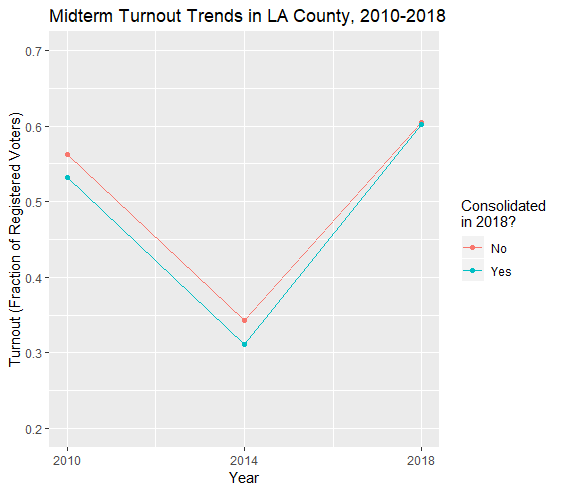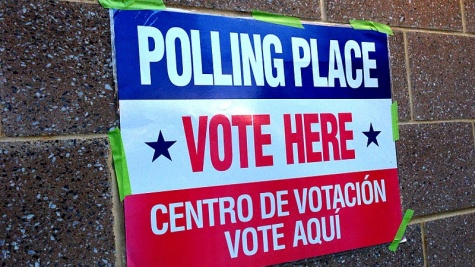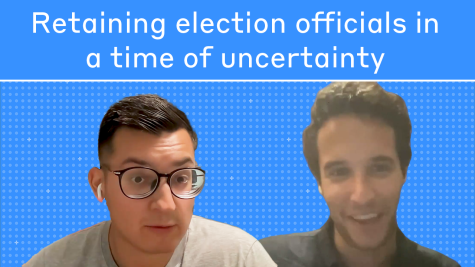The Effect of Election Consolidation on Turnout
Evidence from California
The MIT Election Data and Science Lab helps highlight new research and interesting ideas in election science, and is a proud co-sponsor of the Election Sciences, Reform, & Administration Conference (ESRA).
Connor Phillips recently presented a paper at the 2019 ESRA conference entitled, “The Effect of Election Consolidation on Turnout: Evidence from California.” Here, he summarizes his analysis from that paper.
In most US jurisdictions, local elections (which include municipal, special and school district, and sometimes even county and state elections,) are held separately from federal elections. This practice has numerous repercussions for election outcomes and public policy: research by Sarah Anzia has demonstrated that interest groups are able to exercise disproportionate influence in these low-turnout, off-cycle elections — for example, teachers’ unions in school board races.
Several states, including Michigan, California, Kentucky, and Nevada, are considering or have implemented legislation that moves these lower-level contests to coincide with the federal elections held in November of even-numbered years. These reforms increase turnout in the local elections, since the relatively large portion of the electorate that turns out to vote for the President or Congress now also has the opportunity to vote in these races. What is less well understood is whether such policies have any effect on participation in the state and national contests that now share the ballot with local races.
Research
To investigate this question, I analyzed a recent election reform in the state of California known as SB 415. Enacted in 2015, this law requires municipal elections in most California cities to be held on the same day as statewide primaries or general elections. In practice, this meant that many cities that elected mayors and city council members at another time moved these contests to the federal Election Day, when California also holds its state elections. Since compliance is not required until 2022, however, some cities began holding their municipal elections on the new schedule in 2018 while others chose to wait until 2020. Still others were exempt from the law because they held a home rule charter, while cities whose elections already coincided with statewide ones did not have to move them.
Therefore, comparing the change in turnout between statewide general elections in cities that moved their contests — that is, those that held separate local elections in one cycle and consolidated them with the statewide election in the next — to the change in turnout between those same elections in cities that did not change their election times can yield an estimate of how much combining local elections with state and federal ones boosts or diminishes turnout. (This technique is known as a difference-in-differences analysis.) Specifically, I compared turnout changes between the 2014 and 2018 midterm elections.
Results
My results indicate that when cities joined their municipal elections with the statewide one, turnout among registered voters rose by three percentage points more than would be expected, assuming that the cities that moved their elections between those cycles would have followed the same turnout trend in the absence of consolidation as the cities that did not move. In the context of the 2018 election, this represents about a 5% increase in overall turnout — a significant number, given that municipal elections are not typically regarded as drivers of political participation, especially when compared with federal or state contests.
The figure below displays this finding graphically for Los Angeles County (the largest county in California, containing 88 of its 482 municipalities), where turnout data is available going back through 2010. While aggregate turnout swung dramatically in these different midterms, the cities that consolidated their elections between 2014 and 2018 saw a relatively greater boost between these two years than did the cities that maintained the same election schedule over this time, as we would expect if election consolidation did indeed raise turnout.
Several caveats apply to this research. These findings are preliminary and suggestive; although the difference-in-differences framework here provides a strong basis to claim that election consolidation caused higher turnout, it is still important to acknowledge potential violations of the assumptions behind this approach (in particular by exploring the possibility that cities that moved their elections in time for the 2018 cycle might have been expected to experience higher turnout), as well as the mechanism that produced this effect. Reviewing the voter file might help to arbitrate between potential explanations, including more concentrated campaign mobilization, decreased voter fatigue, or simply the participation of an additional group of municipal-issues-minded voters.
What implications does this analysis have for election administration? Certainly, if boosting turnout in the aggregate is a main objective of reformers, then moving local elections to a state or national election date seems to be an effective means of doing so: Not only does it bring more voters to low-salience races, but it also increases participation in federal elections, an area in which America still lags behind other developed countries.
Nevertheless, these findings raise further questions. First, it is important to establish whether this effect replicates outside of California and whether its size varies in different contexts. For instance, are there diminishing or increasing returns to moving additional categories of elections to November of even years? Second, bringing more people to the polls may have negative consequences. Longer ballots might render it more cognitively difficult for voters to make a choice in all contests, leading to increased rates of roll-off. Further, to the extent that at least some of these “extra” voters are participating primarily out of their interest in local races, they may be casting uninformed votes in federal elections, or even not participating in these contests at all. Scrutiny of both voter-file records and roll-off rates in the context of reforms like California’s, as well as examination of their public-policy effects, would provide valuable insights into the second-order implications of these measures that would help policymakers across the country decide whether to pursue them.
![A line graph depicts "Midterm Turnout Trends in LA County, 2010-2018." The y-axis depicts "Turnout [as a] (Fraction of Registered Voters," and compares cities that consolidated their 2018 elections to those that did not. the cities that consolidated their elections between 2014 and 2018 saw a relatively greater boost between these two years than did the cities that maintained the same election schedule over this time, as we would expect if election consolidation did indeed raise turnout.](/sites/default/files/styles/single_image_1x/public/1_h_XxsABefMtpJd4KpiMDzA.png?itok=1dBcfcP0)



